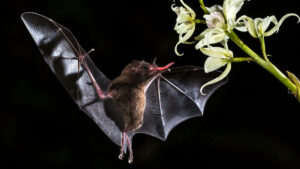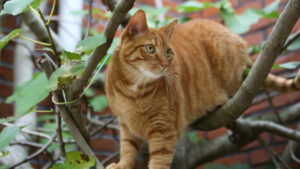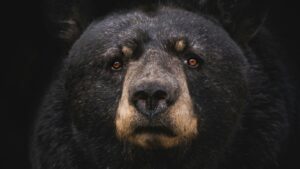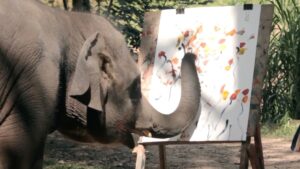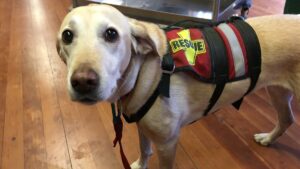Dogs, our furry four-legged companions, never cease to amaze us with their antics. One of the most intriguing and adorable behaviors they exhibit is tail wagging. But have you ever wondered, “Why do dogs wag their tails?” Is it just a random expression of joy, or is there more to it than meets the eye? Well, in this “tail-tastic” journey, we are going to decode the language of a dog’s tail and uncover the various emotions and messages it conveys to us and other canines.
Dog tail wagging: Joyful jig
Let’s kick things off with the most common and heartwarming sight — the joyful tail wag. You come home after a long day at work, and there’s your pup, tail wagging like a windshield wiper at full speed. It’s like they’ve just won the lottery! But this exuberant tail wag is more than just a welcome dance — it’s their way of saying, “I’m thrilled to see you!”
Dogs communicate their happiness through this tail motion, and it’s hard not to smile when you witness it. In its own way, a canine telling you that you’re their world, and your presence is the highlight of their day. So, next time your dog’s tail is doing the happy dance, know that you’re their best buddy!
Nervous noodle

Tail wagging isn’t always a sign of happiness — sometimes, it’s a signal that your furry friend is feeling a tad anxious or unsure, per PetMD. You take your pup to the vet’s office, and their tail is wagging, but their body seems tense, and their ears are flat against their head. That’s the nervous noodle wag.
This kind of wagging can be your dog’s way of saying, “I’m not quite sure about this situation, but I’m trying to stay calm.” It’s like they’re trying to convince themselves that everything is going to be okay. When you see this type of wag, be patient and try to make your dog feel more comfortable.
Friendly flag dog tail wag
Dogs are social creatures, and they love making new friends, whether they have two legs or four. When a dog approaches another dog with a wagging tail, it’s like they’re extending a friendly handshake. The tail serves as a flag of goodwill, signaling their intent to be sociable and non-threatening.
When dogs meet, they often engage in a little tail talk, with each tail sending and receiving signals. If your dog wags their tail when it meets a new furry pal, it’s their way of saying, “Hey, let’s be friends!” It’s like the universal language of the dog world.
Territorial twirl
Now, not all tail wags are about making friends. Some are more about asserting dominance or guarding their territory. The territorial twirl is a slower, deliberate wag, often accompanied by raised hackles and a stiff body posture.
When a dog wags their tail in this manner, it’s like they’re saying, “This is my turf, buddy!” It’s a signal to other dogs that they should think twice before encroaching on their space. If you see your dog doing the territorial twirl, it might be best to give them some space and respect their boundaries.
Insecure flutter
Just like humans, dogs can have moments of insecurity. When a dog is feeling uncertain or vulnerable, it may exhibit a fluttering tail wag. This wag is quick and low to the ground, almost like a hesitant flutter of a butterfly’s wings.
In these moments, your dog might be saying, “I’m not quite sure about this situation, and I need some reassurance.” It’s essential to be patient and comforting when you notice this type of tail wag. Your furry friend may need some extra love and support to boost their confidence.
Playful pirouette
Playtime is one of the best parts of being a dog, and their tail often becomes a key player in their playful antics. The playful pirouette is a wild, all-over-the-place wag that accompanies zoomies, fetch, and other fun activities.
When your dog’s tail is doing the playful pirouette, it’s as if they’re saying, “Let’s have a blast!” This wag is contagious, and you’ll likely find yourself joining in on the fun. So, grab a toy and let the games begin!
Sad sag wag
Just as dogs express joy and excitement through their tails, they also convey sadness and disappointment. The sad sag is a downward droop of the tail, often accompanied by a low head and ears pressed back.
When your dog’s tail is sagging, they’re communicating, “I’m feeling down or upset.” It’s important to be attentive to your furry friend’s emotional state and offer them comfort and support during these times. A little extra cuddle time can go a long way.
Tail of trust
The bond between a dog and its human is a special one, built on trust and love. When your dog wags their tail while looking into your eyes, it’s a unique tail talk that signifies trust and affection.
This tail wag says, “You are my person, and I trust you completely.” It’s a beautiful moment that reminds us of the deep connection we share with our canine companions.
Dogs wag their tails to communicate in many ways
In the world of dogs, the tail is a versatile tool for communication. It’s their way of expressing joy, anxiety, friendliness, dominance, insecurity, playfulness, sadness, and trust. By understanding the language of a dog’s tail, we can strengthen our bond with our furry friends and provide them with the love and support they need.
When your dog wags their tail, take a moment to listen to what they’re saying. It’s a tail talk that speaks volumes, and it’s a beautiful reminder of the incredible connection we share with our canine companions. Wag on, dogs, wag on!
RELATED: Dog Breaks World Record for the Longest Tongue — Longer Than a Soda Can!
Header image: Dog wagging tail / Berkay Gumustekin via Unsplash
I’m Mark Putzer, and my passion for animals and all things nature is a life-long love affair. Growing up in Wisconsin, I had many cherished memories of hiking, skiing, and enjoying the abundant wildlife in the Badger State.
My passion for animals led me to marine biology research for my studies at the University of Wisconsin. I researched the behavior and communication of humpback whales around Hawaii and Orca Whales around the San Juan Islands of Washington State. The experience of being close to these massive and magnificent creatures is amazing. Later, I taught outdoor education to children in California — passing along my knowledge of animals and nature to the curious minds of the next generation. I also love pets. This includes a Labrador Retriever dog named “Molly” when I was a kid — and now, an adventurous tabby cat named “Rosy.”
I’m here to share the wonders of the animal kingdom with you. Whether it’s a cherished pet at home or an animal out in the wild, there are many unique stories and interesting information to share on Weird Animal News! Enjoy!


